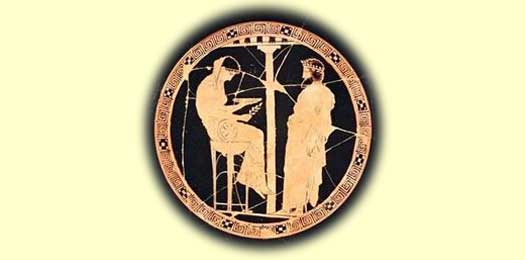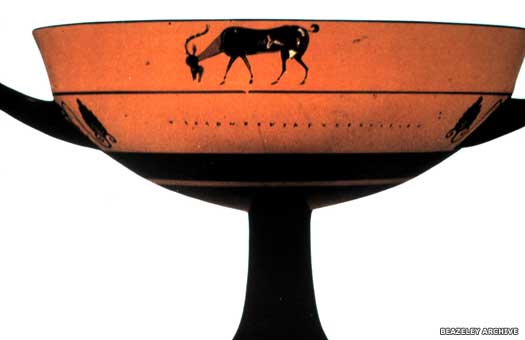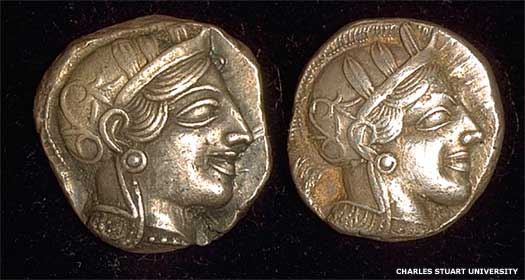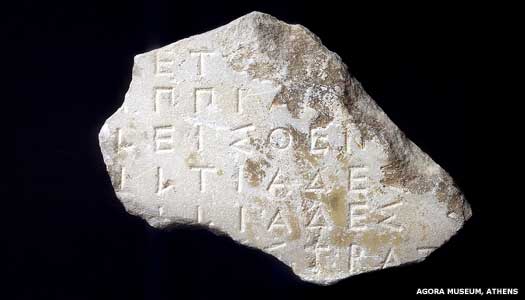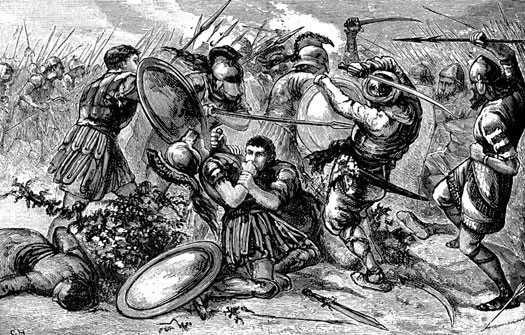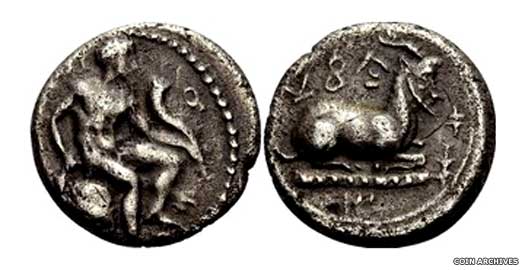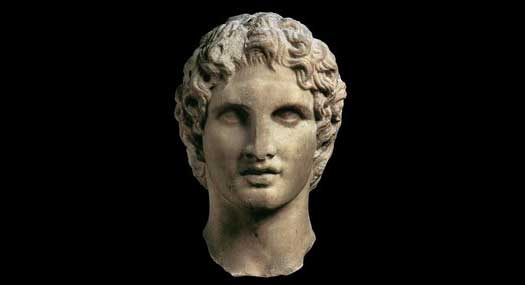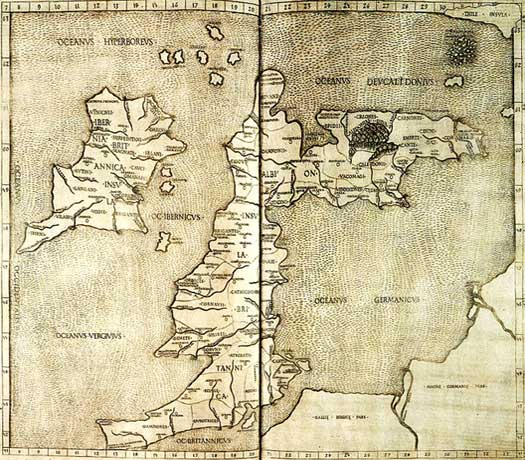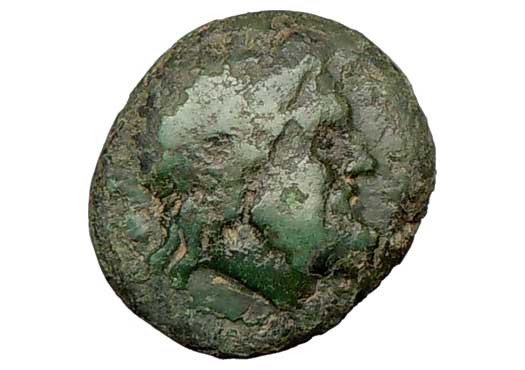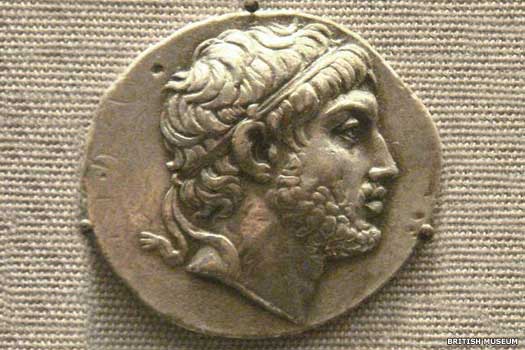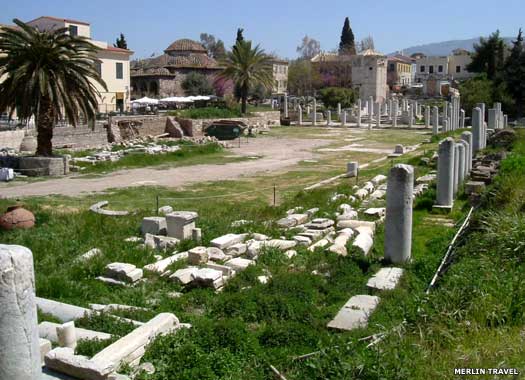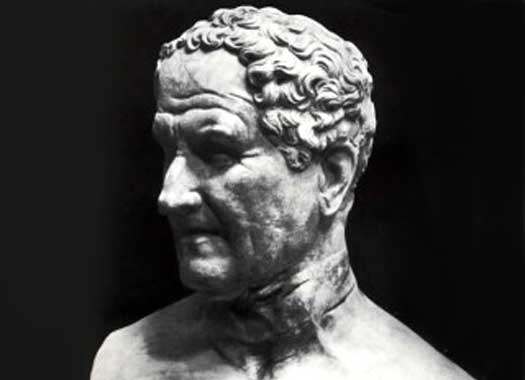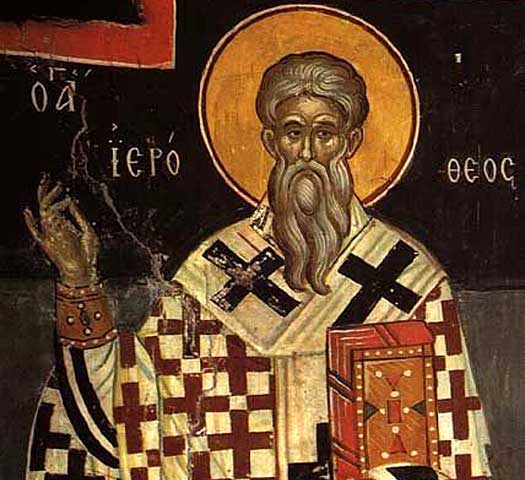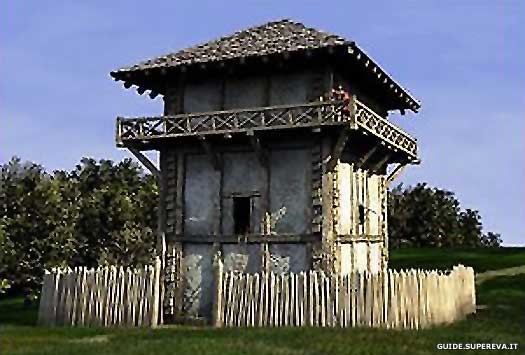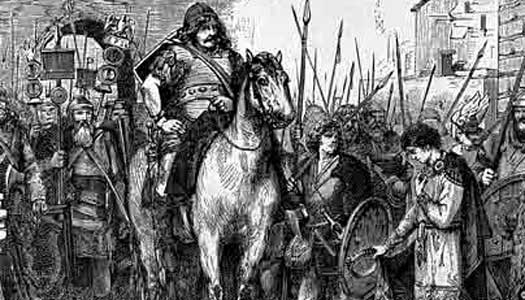
| ATHENS (MYCENAEANS) The site that later became Athens was occupied from at least as early as 5000 BC. The first signs of habitation were found at the Cave of Schist. By the sixteenth century BC the settlement had become an important centre of Mycenaean civilisation, and a major fortress existed at the site. Much of Greece remained under Minoan domination until around the fifteenth century BC, at which point its Mycenaean inhabitants gained independence and established a series of powerful city states of their own.
At the end of this period, by the twelfth century BC, Athens became the bolt-hole for those Mycenaeans who remained in Greece, possibly along with a population of Pelasgians, while the rest of the country was invaded by the barbarian Dorians from the north. Athens found itself cut off by this invasion, as the rest of Greece (and a great swathe of the Near East) entered a dark age. The city endured an impoverished culture, retaining only a local sphere of influence and limited trade until the end of the dark age.
Once a full recovery was underway in the eighth and seventh centuries, Athens was able to trade with the Phoenician city states, and with Syria as a whole, with papyrus being imported from there and locations being used in stories about the Greek gods. The Greeks imported the Phoenician alphabet and eastern artistic influences, and were firmly a part of the trade system of the region. By this time they had ditched their (semi-legendary) kings and were well on the way to creating the world's earliest-known democracy.
(Additional information from The Iliad, Homer (Translated by E V Rieu, Penguin Books, 1963), and from External Link: Miletus (Perseus Digital Library).)
fl c.1500 BC :
Actaeus : First king of Attica, which was inherited by Cecrops.
Cecrops I : Half-man half-serpent. Regarded as the first king of Athens.
c.1470 BC :
During his reign of fifty-six years, Crecops is credited with deifying Zeus, adopting Athena as the patron goddess of the city, and introducing literacy and marriage. During this period, Greece is still under the domination of the Minoans, but the volcano at the heart of the island of Thera erupts around this time, ending Minoan dominance of the Mycenaeans. The various Mycenaean city states begin to dominate not only Greece but the islands of the Aegean and Crete itself.
Erysichthon : Son. Predeceased his father and did not rule.
Cranaus : Athens' wealthiest citizen. Reigned for 9 or 10 years.
Cranaus is deposed by Amphictyon who is in turn deposed by Erichthonius. Amphictyon is the son of Deucalion, who apparently flees to Athens to escape a flood. His son marries a daughter of Cranaus.
Amphictyon : Son-in-law. Usurped the throne. Ruled 10 or 12 years. Deposed.
Erichthonius / Erichthonios : Brother. Drove out Amphictyon.
Pandion I : Son.
Erechtheus : Son. His grandson was Menestheus, king of Athens.
Cecrops II : Son. Ruled for 40 years.
c.1300/2600 BC :
Pandion II : Father of Lycus of Lycia in Greek mythology, and of Aegeus.
Metion : Seized the throne.
Upon the death of Pandion II (a legendary king who is perhaps confused with an earlier namesake in his possible dating to circa 2600 BC), Metion seizes the throne. The four sons of Pandion wrest back control of Athens and divide control of the city state between them, with Aegeus becoming king. One of the brothers, Lycus, is also claimed as the founder of Lycia.
Aegeus / Aigeus / Aegeas / Aigeas : Son of Pandion. King of Athens, and father of Theseus.
Medea, the abandoned wife of Jason of Iolkos, flees to Thebes and then Athens, where she marries King Aegeus. When his son, Theseus, returns Medea leaves for Kolkis, where she kills her usurper uncle and restores her father to his throne.
Aegeus, grandson of the semi-mythical King Erichthonius of Athens, consults the Oracle at Delphi for advice regarding his lack of a male heir despite two marriages fl c.1200 BC :
Theseus : Son. Aged 70, raped the teenaged Helen of Sparta.
1200 - 1140 BC :
Mycenaean power is gradually eroded by the invading Dorians from the north, with domination coming by about 1140 BC. The surviving Ionic-speaking Mycenaeans gather and flourish in Athens, or in conquered Mediterranean territories which probably include Phillistia.
fl c.1183 BC :
Menestheus : Son of Peteus, son of Orneus, son of Erechtheus.
c.1193 - 1183 BC :
Agamemnon of Mycenae calls to arms the forces of his allied Achaean kingdoms, including Athens, to take part in the Trojan War. Menestheus, king of Athens since Theseus travelled to the Underworld, takes fifty black ships in support of the siege of Troy but seems to be rather shy of being involved in the fighting himself. After the war is over, he sails to Mimas and then Melos, where he becomes king, ruling jointly over that and Athens until his death.
Demophon : Son of Theseus. Fought in the Trojan War.
Oxyntes : Son.
Ampheidas : Son. Reigned for 1 year.
Thymoetes : Brother. The last descendant of Theseus to rule.
c.1126 - 1089 BC :
Melanthus : Former king of Messenia. Succeeded or overthrew Thymoetes.
c.1089 - 1068 BC :
Codros / Codrus : Last king. Position replaced by the Archons.
c.1068 BC :
Codros sacrifices himself to prevent an oracle regarding the Doric conquest of the city from coming true. In doing so, he preserves the Mycenaean bloodline that survives in Athens when all of Greece has fallen to the Dorians. His heirs become hereditary Archons, or lords, of Athens, with his son, Medros, the first of these. Another son, Neleus, is credited with founding (actually re-founding) the city of Miletus in Caria.
Hereditary
Archons of Athens :
The first step towards establishing the earliest known democracy (although the Athenians of the time were not to know that this is where their actions would lead them) was the abolition of the kingship around 1068 BC. In its place the position of archon, or lord, of Athens was created. In other Greek cities the position was that of the chief magistrate, an office which the later Romans would perpetuate and which, in post-Roman Britain at least, would often be the equivalent of a king. In Athens it was an assignment for life, and the power held was, again, virtually equivalent to that of a king. Medros, the son of the last king, became the first archon.
1068 - 1048 BC :
Medon : Son of Codros. First hereditary archon.
1048 - 1012 BC :
Acastus
1012 - 993 BC :
Archippus
993 - 952 BC :
Thersippus
952 - 922 BC :
Phorbas
922 - 892 BC :
Megacles
c.900 BC :
Iron Age burials from this point onwards, in the Kerameikos and other locations, are often richly provided for and demonstrate that Athens has already become one of the leading centres of trade and prosperity in the region. This may be due to its secure stronghold on the Acropolis and its access to the sea which give it a distinct advantage over inland cities such as Sparta and Thebes.
892 - 864 BC :
Diognetus
864 - 845 BC :
Pherecles
845 - 825 BC :
Ariphron
824 - 797 BC :
Thespieus
796 - 778 BC :
Agamestor
778 - 755 BC :
Aeschylus
755 - 753 BC :
Alcmaeon : Last hereditary archon.
Elected
Archons of Athens (Classical Period) :
The virtual kingship of the previous archons was abolished in favour of an elected official. Initially the term of office was ten years, and the individuals who held office under these terms are known as the decennial archons. In 683 BC the term of office was limited to just one year, the annual archons, with each candidate being selected from amongst the members of the Areopagus council. The polemarch headed the city's defensive forces, while the archon basileus handled the religious duties, including the ceremonial functions remaining from the former kingship.
As one of the leaders of Greece's emergence from the post-Hittite dark age, this city state experienced periods of turmoil, but out of that turmoil evolved the same evolution of philosophy and a spirit of examination of all the world contained that was starting to take place in contemporary China. A full recovery was underway by the eighth century BC and into the seventh, and Athens developed trade with the Phoenician city states, and with Syria as a whole. Papyrus was imported and these strange new locations were used in stories about the Greek gods. The Phoenician alphabet and eastern artistic influences were also imported, helping to lay the foundations for the world's earliest-known democracy.
(Additional information from The Persian Empire, J M Cook (1983), from The Histories, Herodotus (Penguin, 1996), from The Greek Settlements in Thrace until the Macedonian Conquest, Benjamin H Isaac, from the BBC series, The Story of China, by Michael Wood, first broadcast between 21 January and 25 February 2016, and from External Link: Encyclopaedia Iranica.)
753 - 743 BC :
Charops : First of the decennial archons.
c.750 BC :
By this time the Greek world has largely taken shape as a collection of city states, often at war with one another, but also feeling certain common ties of language, religion, and customs. The system mirrors the pre-dark age world of the Mycenaeans, perpetuated in their surviving mainland heirs, the Athenians.
743 - 733 BC :
Aesimides
733 - 723 BC :
Clidicus
723 - 713 BC :
Hippomenes
713 - 703 BC :
Leocrates
703 - 693 BC :
Apsander
693 - 683 BC :
Eryxias : Last of the decennial archons.
682 - 681 BC :
Creon : First of the annual archons.
681 - 680 BC :
Lysiades
680 - 679 BC :
Tlesias
679 - 671 BC :
? : Eight archons, names unknown.
671 - 670 BC :
Leostratus
670 - 669 BC :
? : Name unknown.
669 - 668 BC :
Pisistratus
668 - 667 BC :
Autosthenes
667 - 664 BC :
? : Three archons, names unknown.
664 - 663 BC :
Miltiades
663 - 659 BC :
? : Four archons, names unknown.
659 - 658 BC :
Miltiades
658 - 645 BC :
? : Thirteen archons, names unknown.
645 - 644 BC :
Dropides
644 - 639 BC :
? : Five archons, names unknown.
639 - 638 BC :
Damasias
638 - 634 BC :
? : Four archons, names unknown.
634 - 633 BC :
Epaenetus
633 - 632 BC :
? : Name unknown.
632 - 631 BC :
Megacles : Subdued an attempted coup.
632 BC :
Cylon (or Kylon or Kulon) is an Athenian noble and previous Olympic Games winner. He attempts a coup with support from Megara, of which his father-in-law, Theagenes, is tyrant. The coup is opposed, and Cylon and his supporters take refuge in Athena's temple on the Acropolis. Cylon and his brother escape, but his followers are cornered and killed by the archons, led by Megacles. This is the first reliably datable event in Athenian history.
Athenian black figure pottery began to be created around 630 BC, although the earlier date of about 700 BC is claimed for Corinth - by the 630s it was certainly the dominant form of pottery 631 - 624 BC :
? : Seven archons, names unknown.
624 - 623 BC :
Aristaechmus
623 - 621 BC :
? : Two archons, names unknown.
621 - 620 BC :
Draco : Reformed the city's legal code.
621/620 BC :
During the 39th Olympiad, and as a partial result of the attempted coup of 632 BC, Draco reforms the laws of Athens, establishing a legal code which replaces the previous system of oral law and blood feuds with court-enforceable laws. The laws are viewed as being harsh, hence the term 'draconian', but are generally welcomed by the people who are no longer at the mercy of nobles who could make up the law as they saw fit.
620 - 615 BC :
? : Five archons, names unknown.
615 - 614 BC :
Heniochides
614 - 605 BC :
? : Nine archons, names unknown.
605 - 604 BC :
Aristocles
604 - 600 BC :
? : Four archons, names unknown.
600 - 599 BC :
Critias
599 - 597 BC :
? : Two archons, names unknown.
597 - 596 BC :
Cypselus
596 - 595 BC :
Telecles
595 - 594 BC :
Philombrotus
594 - 593 BC :
Solon
593 BC :
The nobles of Athens have been growing increasingly worried by the expanding body of complaints from the commoners of Athens. Solon is given extraordinary powers to reform the state and ease the tensions between the different classes. He passes economic and political reforms that lay the foundations for the city's later greatness.
593 - 592 BC :
Dropides
592 - 591 BC :
Eucrates
591 - 590 BC :
Simon
590 - 589 BC :
The city is briefly in a state of anarchy, probably as tensions continue to grow between the classes. This is despite Solon's reforms which have eased the situation somewhat but not removed it.
589 - 588 BC :
Phormion
588 - 587 BC :
Philippus
587 - 586 BC :
? : Name unknown.
586 - 585 BC :
Another period of anarchy grips the city and no archon is elected during it. Fighting takes place between the Hill (peasants on small farms), Shore (artisans and traders), and Plain (nobles) factions.
585 - 582 BC :
? : Three archons, names unknown.
582 - 581 BC :
Damasias : Founded the 'Seven Sages.
c.582 BC :
The 'Seven Sages' are created during the archonship of Damasius. Thales of Miletus, mathematician, astronomer, and pre-Socratic philosopher, is counted as the first sage. Details about his heritage conflict, either placing him in Miletus as the son of a Greek woman and Phoenician-descended man, or having him emigrate there from Athens (the cities have been closely linked for centuries). Once there, aside from his teachings, he is present on the campaign by Croesus of Lydia in 547 BC against Cyrus the Great.
581 - 580 BC :
Damasias : Second term of office. Expelled.
580 - 578 BC :
Damasias is expelled during his second term of office. During a renewed spell of anarchy in Athens, a committee of ten fulfils the role of archon in 580-579 BC, but apparently it fails to survive beyond that. The city remains ungoverned until 578 BC.
578 - 577 BC :
? : Name unknown.
577 - 576 BC :
Archestratidas
576 - 570 BC :
? : Six archons, names unknown.
570 - 569 BC :
Aristomenes
569 - 566 BC :
? : Three archons, names unknown.
566 - 565 BC :
Hippocleides
565 - 561 BC :
? : Four archons, names unknown.
561 - 560 BC :
Comeas
561 BC :
Fighting in Athens continues between the Hill (peasants on small farms), Shore (artisans and traders), and Plain (nobles) factions. Eventually, the leader of the hill faction, Peisistratus, gains the upper hand. Athens falls under his rule as tyrant (although tyrant should be used in the Greek sense, not its modern sense). Peisistratus dominates Athens as a benevolent dictator, and becomes highly popular thanks to making the city very wealthy and powerful.
561 - 556 BC :
Peisistratus / Pisistratus : Tyrant. Expelled, but returned the following year.
560 - 559 BC :
Hegestratus : First archon elected under the tyrant's rule.
559 - 558 BC :
Hegesias
558 - 556 BC :
? : Two archons, names unknown.
556 - 555 BC :
Hegesias
556 - 555 BC :
Peisistratus is briefly expelled, but returns the following year, regaining control over Athens.
Two coins issued during the tyranny of Peisistratus in Athens, who became the master of the city by force of arms (hence the traditional title of tyrant), and who was twice restored to his position 555 - 550 BC :
Pisistratus : Restored tyrant. Expelled for the second time.
555 - 554 BC :
Euthidemus
554 - 548 BC :
? : Six archons, names unknown.
c.550 - 546 BC :
Peisistratus is expelled again, but once again returns to regain his control of Athens, this time four years later. At the third attempt he fully establishes his, apparently benevolent, dictatorship of the city.
548 - 547 BC :
Erxicleides
547 - 546 BC :
Thespius
546 - 528 BC :
Pisistratus : Restored as tyrant for the second time.
546 - 545 BC :
Phormion
545 - 535 BC :
? : Ten archons, names unknown.
536 - 535 BC :
Phrynaeus
535 - 533 BC :
? : Two archons, names unknown.
533 - 532 BC :
Thericles
532 - 528 BC :
? : Four archons, names unknown.
528 BC :
Peisistratus dies peacefully and is succeeded by his two sons, who apparently rule jointly. They continue their father's policies, at first successfully, but Hipparchus begins to abuse his power.
528 - c.510 BC :
Hippias : Son and successor to Peisistratus as tyrant. Assassinated.
520 - c.514 BC :
Hipparchus : Brother. Co-tyrant. Overthrown.
528 - 527 BC :
Philoneus
527 - 526 BC :
Onetorides
526 - 525 BC :
Hippias
525 - 524 BC :
Cleisthenes : Grandson of the king of Sicyon.
524 - 523 BC :
Miltiades
523 - 522 BC :
Calliades
522 - 521 BC :
Pisistratus
521 - 518 BC :
? : Three archons, names unknown.
518 - 517 BC :
Hebron
517 - 511 BC :
? : Six archons, names unknown.
c.514 BC :
Hipparchus is assassinated by Harmodius and Aristogeiton, who earn themselves the title of the Tyrannicides. In retaliation, Hippias has them executed, but he becomes bitter, and his rule takes a turn towards increased cruelty.
c.511 - 510 BC :
Hippias is overthrown with the help of Sparta, and the beginnings of Athenian democracy begin to be established. A radical politician of the aristocratic class, named Cleisthenes, takes charge and begins to establish democracy in the city.
511 - 510 BC :
Harpactides : First independent archon since 561 BC.
510 - 509 BC :
Scamandrius
509 - 508 BC :
Lysagoras
508 - 507 BC :
Isagoras : Son of Tisander. Exiled by Cleisthenes.
508 - 507 BC :
A friend of Cleomenes I of Sparta, Isagoras is elected archon after having remained in Athens during the tyranny of Hippias. His appointment is opposed not only by Cleisthenes but by the majority of the city's population. Isagoras and Cleomenes work to get Cleisthenes expelled from the city, but a general Athenian revolt sees Isagoras instead being trapped and exiled, while three hundred of his supporters are executed. Cleisthenes returns as archon.
508 - 507 BC :
Cleisthenes : Competed with Isagoras. Expelled by Cleomenes I of Sparta.
508/507 BC :
The populace of Athens creates the world's first organised democracy. Although it is copied by other Greek cities, it is the best recorded of them all, and the most stable. It is handled on a very restricted basis, with women and anyone without two Athenian-born parents ineligible to vote. In fact, the position of women in this democracy is surprisingly low. It is possible that the world's first face veil is invented for women in Athens.
The School of Athens by Italian Renaissance artist Rafael (1483-1520) represents philosophy by including such figures as Aristotle (centre, in sky blue) and Plato (centre, in purple and red) While the date of 508 BC (or 507 BC) is given here, there is a great deal of uncertainty about the precise moment at which Athenian democracy emerges, with dates between 510-500 BC being given. As it is known that Cleisthenes champions this radical political reform in the face of the increasingly hard rule of the tyrant Pisistratus (522-521 BC), it seems appropriate to place it here.
In 507 BC the Athenians are threatened with attack on three fronts by hostile Greek neighbours. They send to Sardis, capital of the Persian satrapy of Sparda, asking for a Persian alliance. This involves the Greek envoys recognising Persian suzerainty, something which the Athenians promptly disavow after the emergency is over. The Persians probably see it differently, viewing the Athenians as rebellious subjects when they renounce the alliance, what Darius the Great calls 'the Lie'.
507 - 506 BC :
Alcmeon
506 - 504 BC :
? : Two archons, names unknown.
504 - 503 BC :
Acestorides
503 - 501 BC :
? : Two archons, names unknown.
501 - 500 BC :
Hermocreon
500 - 499 BC :
Smyrus
499 BC :
The Ionian Greeks of western Anatolia and the islands of the eastern Aegean who are under Persian hegemony now rise in the Ionian Revolt. The Carians join in and, with the Ionians being led by Aristagoras, tyrant of Miletus, they inflict heavy losses on the Persians. Similar revolts arise in Aeolis, Salamis, and Doris as the Greeks see a chance for freedom. Athens sends troops to aid the Ionian islands but the Persians gradually gain the upper hand and the revolt begins to crumble.
499 - 498 BC :
Lacratides
498 - 497 BC :
? : Name unknown.
497 - 496 BC :
Archias
496 - 495 BC :
Hipparchus
495 - 494 BC :
Philippus
494 - 493 BC :
Pythocritus
493 BC :
The end of the Ionian Revolt probably sees the Persians breath a sigh of relief that these troublesome Greeks are back under proper control. The main leader of the revolt, Aristagoras of Miletus, flees to Thrace in the hopes of setting up a colony outside Persia's control, but he is killed in a battle against a nearby town. His chosen successor in Miletus is Pythagoras, but Darius the Great kills the men of the city and enslaves its women and children, ensuring that the city is deserted. For its part in the revolt, Athens will soon face the first of two Persian invasions of Greece itself.
493 - 492 BC :
Themistocles : Archon and pre-eminent Athenian. Banished.
492 - 491 BC :
Diognetus
491 - 490 BC :
Hybrilides
490 BC :
In response to the Athenian support of the Ionian Revolt, Darius the Great invades mainland Greece. Athens is sacked, but only after its citizens withdraw safely, and subsequently the Persian invaders are defeated by Athens and Plataea at the Battle of Marathon in August or September of the year. During this period, Callimachus and Miltiades are strategoi for Athens.
490 - 489 BC :
Phaenippus
489 - 488 BC :
Aristides the Just
488 - 487 BC :
Anchises
487 - 486 BC :
Telesinus
486 - 485 BC :
Ceures
485 - 484 BC :
Philocrates
484 - 483 BC :
Leostratus
483 - 482 BC :
Nicodemus
483 BC :
A rich seam of lead is found in the mines of Laurion in southern Attica, to the south of Athens. Silver is located within this seam, making Athens suddenly a very rich city. It also becomes a very slave-rich society, as workers are needed to dig the mines. Themistocles, still a highly-influential politician, persuades the democratic assembly to start a crash ship-building programme. The goal is two hundred triremes, trebling Athenian naval power. This fleet proves vital at the end of the decade.
482 - 481 BC :
? : Name unknown.
481 - 480 BC :
Hypsichides
480 - 479 BC :
Calliades
480 - 479 BC :
Invading Greece in 480 BC, the Persians subdue the Thracian tribes (except for the Satrai, precursors to the Bessoi) and the Macedonians. Then the vast army of the Persian King Xerxes makes its way southwards and is swiftly engaged by Athens and Sparta in the Vale of Tempe. The Persians are subsequently stymied by a mixed force of Greeks - which includes Athenians, Corinthians, Helots, Mycenaeans, Thebans, and Thespians - led by Sparta under King Leonidas at Thermopylae. (These events are depicted somewhat colourfully - but no less impressively for that - in the 2007 film, 300.)
Athens, as the leader of the coalition of city states known as the Delian League, fights the Persian navy at the battles of Artemisium and Salamis, the latter being a resounding Greek victory. It leaves much of the Persian navy destroyed and Xerxes is forced to retreat to Asia, leaving his army in Greece under Mardonius (with the naval battles being shown to superb graphic effect in the 2014 sequel film, 300: Rise of an Empire, although it does contain a great many historical inaccuracies). As a reward for his support of Xerxes during the war, the exiled Demaratus of Sparta is granted a satrapy of his own in Pergamum, whilst Queen Artemisia I of Halicarnassus in KarkÔ is sent to Ephesus to care for the sons of Xerxes. The following year, Mardonius meets the Greeks in a final battle. The Spartans, now at full strength, lead a pan-Greek army at the Battle of Plataea in 479 BC which decisively defeats the Persians and ends the Greco-Persian War.
480 - 400? BC :
The northern coastal region of the Persian satrapy of Katpatuka is carved off to form a new province called Pontus. The exact date at which this occurs is unknown, but it is an established fact by the time of Xenophon of Athens in the first half of the fourth century BC.
479 - 478 BC :
Xanthippus : Father of Pericles.
479 - 460s? BC :
Following the evacuation of Xerxes and his great army, many of the Persian governors in Thrace are defeated by Greeks and expelled. One exception is Maskames of Doriskos. He holds out bravely, resisting all attempts to dislodge him. The only other local governor to do so is Boges of Eion, but he faces his eventual defeat in 475 BC by walking into the flames of his burning command.
Just how long Doriskos holds out is open to interpretation. Herodotus records 'many attempts' by the Greeks to reclaim it, which must cover several years, but some opinion goes so far as to say that the Greeks never recover the city. Instead it is eventually taken over by Thracians.
478 - 477 BC :
Timosthenes
477 - 476 BC :
Adimantus
476 - 475 BC :
Phaedon
475 - 474 BC :
Dromoclides
474 - 473 BC :
Acestorides
473 - 472 BC :
Menon
472 - 471 BC :
Chares
471 - 470 BC :
Praxiergus
470 - 469 BC :
Demotion
469 - 468 BC :
Apsephion
469 BC :
Athenian statesman and general, Kimon (or Cimon) leads an allied Greek fleet to Caria. The attack focuses on destroying Persian strongholds as far as Phaselis on the border with Pamphylia. The response from Xerxes is to send an army under Pherendates to Pamphylia and a joint fleet from Khilakku and Phoenicia (rebuilt after the loss of the Persian fleet in 479 BC) under the command of Tithraustes, a bastard son of Xerxes. The new fleet is destroyed and captured, and the Persian army is utterly defeated.
468 - 467 BC :
Theagenides
468 - 459 BC :
Athens wrests Lycia from the Persians, and it is perhaps this Athenian acquisition of more territory which prompts Admitos of Epirus to oppose Themistocles (the former archon) and his command of Athenian affairs. The issue is rested upon the peaceful death of Themistocles.
The Athenian politician and general Themistocles (archon in 493-492 BC) helped build up the city's navy so that it was a force to be reckoned with when the Persians invaded Greece - thanks to this the Athenian Admiral Cimon was able to defeat the Persians on the banks of the River Eurymedon in Pamphylia in 465 BC 467 - 466 BC :
Lysistratus
466 - 465 BC :
Lysanias
465 - 464 BC :
Lysitheus : Sophanes fulfils the role of strategos (military general).
464 - 463 BC :
Archedemides
463 - 462 BC :
Tlepolemus : Cimon fulfils the role of strategos.
462 - 461 BC :
Conon : Assassinated.
461 - 460 BC :
Euthippus
460 - 459 BC :
Phrasicles
460 BC :
The First Peloponnesian War, between Athens and Sparta, begins. Pleistoanax of Sparta advocates peace, but in 446 BC he is charged by the Spartans with taking a bribe, probably from Pericles of Athens. This is allegedly to encourage him to withdraw from the plain of Eleusis in Attica after leading the Peloponnesian forces there following the withdrawal of Euboea and Megara from the Athenian empire. As a result of the charge he is exiled. His father is regent in his stead. In fact, Pericles had probably been offering good peace terms. In 428 BC, Pleistoanax is recalled and restored in obedience to the advice of the Delphic oracle.
In the same year, Satrap Achaemenes of Egypt is killed at the Battle of Pampremis. His opponents are Inarus (or Inaros), son of a Psamtik and leader of the Second Rebellion in Egypt, and his Athenian allies. It is generally assumed that Psamtik is a member of the dispossessed Saite dynasty. The Greek threat is finally ended in 454 BC when Megabyzus, former satrap of Ebir-nāri, arrives with a fresh army. Inarus is hauled off to Susa where he is reported to be crucified.
459 - 458 BC :
Philocles
458 - 457 BC :
Habron
457 - 456 BC :
Mnesitheides
456 - 455 BC :
Callias : Later involved in the Peace of Callias (447 BC).
455 - 454 BC :
Sosistratus
454/453 BC :
An Athenian army under the command of Myronides marches into Thessaly, being joined by allied Boeotians and Phocians along the way. The campaign is partly in revenge for losses suffered in a previous campaign, but also by a wish to restore Orestes to his native city. Orestes' late father had been an Athenian ally. The campaign ends without a result, and the Athenians return home along with Orestes.
454 - 453 BC :
Ariston
454 BC :
As the 'Halikarnassians' appear in the first Athenian tribute list of 454 BC, most scholars have suggested that the rule of Lygdamis as tyrant of Halicarnassus must end before this date. An opposing theory shows that the tribute list does not necessarily imply that Lygdamis has ceased to rule. Either way, at some point around this date, and probably by 450 BC at the latest, Lygdamis is driven out of Halicarnassus (Herodotus is a visitor to the city very soon after this event). Halicarnassus joins Athen's Delian League until 395 BC.
453 - 452 BC :
Lysicrates
453 - 438 BC :
The Parthenon is constructed on the Acropolis ('high city' or citadel) in Athens as a symbol of the city's power in the Aegean. The costs of construction are paid for from the treasury of the Delian League of independent city states which Athens has commandeered (both the treasury and the league, turning it into the Athenian empire). It is during this period, guided by the legendary orator Pericles, that Athens achieves the height of its power and influence.
452 - 451 BC :
Chaerephanes
451 - 450 BC :
Antidotus
450 - 449 BC :
Euthydemus
449 - 448 BC :
Pedieus
448 - 447 BC :
Philiscus
447 BC :
The Peace of Callias brings the Greco-Persian Wars to an end. The treaty is named after the head of a wealthy Athenian family who is sent to conclude it with Artaxerxes I of Persia. To differentiate him from his grandfather and grandson who share the same name, this statesman is known as Callias II (archon in 456-455 BC).
447 - 446 BC :
Timarchides
c.440s BC :
'Some years' after the expedition by Myronides of 454 BC, Pericles of Athens summons a conference of all the Greeks to confer about the shrines destroyed by the Persians during the invasion of 480-479 BC. Among those invited to attend are the Thessalians, the Phthiot Achaeans (one of the few direct mentions of Phthia itself), the Oetaeans and the Malians. However, opposition by Sparta causes the project to be abandoned.
Around the same time the Greek writer Herodotus uses the word 'Asia' in reference to Anatolia, or perhaps the Persian empire as a whole, in order to differentiate it from Greece or that other great civilisation, Egypt. The origins of the word appear to be in a confederacy in western Anatolia known as Assuwa or Assua. Certainly by about 1400-1300 BC this confederacy had already been formed by a number of regional minor states which, collectively, had been allied to the Hittite empire dominating Anatolia at that time. The city of Troy had counted itself as a member of this confederacy.
Perciles is also responsible for sending a naval expedition to the Greek cities of the Black Sea which are under tribute to Persia, probably soon after 444 BC, making a display of Athenian power, attempting to relieve the cities there from oppression, and to stimulate trade with Attica. It is at Sinope that the efficient Lamachus with thirteen ships is tasked with expelling the tyrant Timesilaus. He does so with great efficiency, and not long afterwards Athens votes to send six hundred volunteer colonists to Sinope to occupy the houses and lands of the defeated tyrant and his followers.
446 - 445 BC :
Callimachus
445 - 444 BC :
Lysimachides
445 BC :
The First Peloponnesian War between Athens and Sparta comes to an end as peace is agreed. In the same year (or in 443 BC), Pericles is elected strategos after the assassination of Ephialtes. He holds the post continuously until 429 BC.
444 - 443 BC :
Praxiteles
443 - 442 BC :
Lysanias
443 - 429 BC :
Pericles is a strategos for Athens for this period. His death in 429 BC brings this unusually long post to an end, but it has overseen a decline in the power of the archons in favour of the strategoi. By this time many Lykian cities have stepped back from their membership of the Athenian League. Only Phaselis and Telmessos remain. An Athenian expedition in 429 BC to force Lykian re-engagement ends in military defeat.
442 - 441 BC :
Diphilus
441 - 440 BC :
Timocles
440 - 439 BC :
Morychides
439 - 438 BC :
Glaucinus
438 - 437 BC :
Theodorus
437 - 436 BC :
Euthymenes 436 - 435 BC :
Lysimachus
435 - 434 BC :
Antiochides
434 - 433 BC :
Crates
433 - 432 BC :
Apseudes
432 - 431 BC :
Pythodorus
431 - 430 BC :
Euthydemus
431 - 404 BC :
The Second Peloponnesian War pitches Athens against Sparta in all-out war as resentment grows at the Athenian dominance of Greece. Fortunes swing either way for several years, but the gradual diminution of Athenian power that results from the wars would also seem to be the catalyst for a virtual cessation of Greek trade with the Illyrian tribes. Greek luxury items stop appearing alongside grave goods after a little more than a century of what must be quite intensive interaction.
A fragment of an Athenian inscription dated about 425 BC which contains part of a list of archons, in this case six of them from the 520s BC 430 - 429 BC :
Apollodorus
429 - 428 BC :
Epameinon
428 - 427 BC :
Diotimus
427 - 426 BC :
Eucles
426 - 425 BC :
Euthynus
425 - 424 BC :
Stratocles
424 - 423 BC :
Isarchus
423 - 422 BC :
Aminias
422 - 421 BC :
Alcaeus
421 - 420 BC :
Aristion
420 - 419 BC :
Astyphilus
419 - 418 BC :
Archias
418 - 417 BC :
Antiphon
417 - 416 BC :
Euphemus
416 BC :
Part of Athens' strategy during the Second Peloponnesian War is to capture the Corinthian colony of Syracuse. The expedition to achieve that is sent off in this year. The expedition has also been requested by the Elymi of Sicily to help in their ongoing struggle against the colony of Selinus.
416 - 415 BC :
Arimnestus
415 - 414 BC :
Charias
414 - 413 BC :
Tisandrus
413 - 412 BC :
Cleocritus
412 BC :
During the Second Peloponnesian War between Athens and Sparta, the failure of the former city and its allied corps of Messapian archers to take the Corinthian colony of Syracuse and the subsequent loss of thousands of troops almost brings the city and its empire to its knees. The Athenian strategoi are executed in Sicily, but the city is able to agree a beneficial trade deal with Macedonia to supply it with copious amounts of wood with which to rebuild the fleet.
412 - 411 BC :
Callias
411 - 410 BC :
Mnasilochus : Died in office.
411 BC :
Sparta's acquisition of Persian gold sees the Athenian fleet starved of huge numbers of freelance rowers and soldiers, giving Sparta dominance both on land and, for the first time, at sea. Athens is defeated in the Second Peloponnesian War and Sparta is established as the greatest Greek power.
Writing at this time about the colonies of Graecia Magna, the reliable Greek historian Thucydides of Alimos (close to Athens), mentions the Siculi. He says that groups of Siculi still occupy the Italian mainland in his time. It is possible, given their close links in the past with the Itali (and therefore their close cousins the Morgetes), that both peoples could be Siculi in all but name.
410 - 409 BC :
Glaucippus
409 - 408 BC :
Diocles
408 - 407 BC :
Euctemon
407 - 406 BC :
Antigenes
406 BC :
Construction of the Temple of the Erechtheum on the Acropolis in Athens is completed. It derives its name from a shrine dedicated to the legendary Greek hero, Erichthonius, and is possibly built by Mnesicles.
406 - 405 BC :
Callias
405 - 404 BC :
Alexias
404 - 403 BC :
Pythodorus : Not recognised during Sparta dominance of Athens.
404 - 403 BC :
Following Athens' total defeat in the Second Peloponnesian War, Sparta sets up the oligarchy of the Thirty Tyrants, which is naturally pro-Spartan and which oversees the exile of many prominent citizens. Pythodorus is not recognised as archon at a time when there is a high level of disenchantment with democracy. However, democracy is restored the following year, 403 BC, by a group of exiles led by General Thrasybulus.
403 - 402 BC :
Eucleides : Athenian democracy is restored.
402 - 401 BC :
Micon
401 - 400 BC :
Xenaenetus
401 BC :
A revolt against the Persian king is led by Cyrus, satrap of Asia Minor. He mobilises an army which also consists of ten thousand Greek mercenaries to attack his brother. Defeat leads to his death in October 401 BC at the Battle of Cunaxa.
Accompanying the many Greeks on this campaign is Xenephon, a notable Greek writer from Athens. He notes that (the now-Persian) Ecbatana is much smaller than the generous estimate given by Herodotus some half a century before him. Xenephon offers a very credible three hundred metres for each of the outer sides, and even claims that it has no walls other than that around the citadel at the very top of the hill. What Herodotus had termed walls (fortifications) could simply be painted terraces, foundations for the road, spiralling up around the hill and leading up to the palace, which at this time is certainly walled and is accented in gold. If the area around the outside of the hill where the road begins its rise is counted as part of the 'city' then its size would come much closer to Herodotus' claims.
The Battle of Cunaxa saw the end of just one in a number of internal Persian revolts that often involved thousands of troops on either side, although in this case the presence of a large body of Greek mercenaries should have been an indicator of the future threat the Greeks would become 400 - 399 BC :
Laches
399 - 398 BC :
Aristocrates
399 BC :
Following the distress of suffering utter defeat in the Second Peloponnesian War, the type of disturbing free speech that the philosopher, Socrates, has long championed can no longer be tolerated. He is tried and condemned to death, with charges of mocking the gods being brought against him. His sentence is to drink poison. His pupil, Plato, later writes him into history as the world's first martyr to free speech.
398 - 397 BC :
Euthycles
397 - 396 BC :
Souniades
396 - 395 BC :
Phormion
395- 394 BC :
Diophandus
395 - 387 BC :
At the start of the Corinthian War, Sparta fights against a coalition of four allied states; Thebes, Athens, Corinth, and Argos; all initially backed by Persia and all riled by Sparta's imperialistic treatment of the rest of Greece. The hold by Athens over its own empire is fading in the face of continual warfare. Halicarnassus (and therefore Caria) is returned to Persian control in 395 BC.
394 - 393 BC :
Ebulides
393 - 392 BC :
Demostratus
392 - 391 BC :
Philocles
391 - 390 BC :
Nicoteles
391 BC :
With the aid of Athens, Evagoras of Salamis leads a successful revolt against Persia and temporarily makes himself master of the island of Cyprus.
Two sides of a coin issued by Evagoras during his Athenian-supported rebellious reign 390 - 389 BC :
Demostratus
389 - 388 BC :
Antipatrus
388 - 387 BC :
Pyrgion
387 - 386 BC :
Theodotus
386 - 385 BC :
Mystichides
387 BC :
The Corinthian War against Sparta ends with the Peace of Antalcidas. Athens loses Lycia to the Persians and gives up its support of the Persian-occupied Ionian islands, but the period of peace allows the city to rebuild its defences and begin a resurgence of its former role as a power in Greece.
385 - 384 BC :
Dexitheus
384 - 383 BC :
Dietrephes
383 - 382 BC :
Phanostratus
382 - 381 BC :
Evandrus
381 - 380 BC :
Demophilus
380 - 379 BC :
Pytheas
379 - 378 BC :
Nicon
378 - 377 BC :
Nausinicus
377 - 376 BC :
Calleas
376 - 375 BC :
Charisandrus
375 - 374 BC :
Hippodamas
374 - 373 BC :
Socratides
373 - 372 BC :
Asteius
372 - 371 BC :
Alcisthenes
371 - 370 BC :
Phrasicleides
371 BC :
In an effort to solve the problem of post-Peloponnesian War conflicts, a pan-Greek conference is called. However, the arrogant Agesilaus II of Sparta picks a fight with Thebes. His fellow Spartan king, Cleombrotus, leads the allied Spartan-Peloponnesian army of about 700 Spartans and 1,300 allies (some reluctant) against a Theban army three times their number under Epaminondas at the Battle of Leuctra. Cleombrotus' death and the utter defeat of his army leads to the Helots being freed and Spartan dominance in Greece being ended forever.
370 - 369 BC :
Dyscinitus
369 - 368 BC :
Lysistratus
368 - 367 BC :
Nausigenes
367 - 366 BC :
Polyzelus
366 - 365 BC :
Ciphisodorus
365 BC :
Ariobarzanus, satrap of Phrygia, and Datames, satrap of Khilakku and Katpatuka, are in revolt against Persian King Artaxerxes II. Autophradates, satrap of Sparda, has been ordered to suppress the rebellion and he has already managed to expel Ariobarzanes from the greater part of his satrapy. Now, in 365 BC, Athens sends thirty ships and 8,000 mercenaries to aid Ariobarzanus. He rewards Athens with the gift of Sestos and Crithote, cities on the Thracian Chersonesus.
365 - 364 BC :
Chion
364 - 360 BC :
Mithridates (sometimes shown as Mehrdad), a son of Ariobarzanus of Phrygia, now occupies Heracleia, the most important Greek city on the Black Sea coast. Soon all of Asia Minor (Anatolia) revolts against Artaxerxes II of Persia.
364 - 363 BC :
Timocrates
363 - 362 BC :
Charicleides
362 - 361 BC :
Molon
362 - 360 BC :
By now even Autophradates, satrap of Sparda, has been driven to join the rebels against Persian King Artaxerxes II. Sparta, and also Takh˘s, pharaoh of Egypt, send substantial help to the rebels. Two years later, in 360 BC, Ariobarzanes is betrayed by his son, Mithridates, and is executed.
Also in 362 BC, Athens and Sparta, together with the Eleans and the Mantinaeans, are defeated by the Thebans at the Battle of Mantinea. The battle is fought on 4 July, with the Thebans being supported by the Arcadians and the Boeotian League. The Spartan defeat paves the way for Macedonian supremacy later in the century.
361 - 360 BC :
Nicophemus
360 - 359 BC :
Callimides
359 BC :
The pretender to the Macedonian throne, Argaeus, attempts to secure the throne with Athenian support. The rightful king, Philip, persuades the Athenians not to interfere. Argaeus gathers his supporters, along with some freelance Athenians, and attempts to capture the capital by force but is repulsed. While retreating back to his headquarters at Methone, he is ambushed by Philip and defeated. He either dies during the fighting or is executed afterwards.
359 - 358 BC :
Eucharistus
358 - 357 BC :
Ciphisodotus
357 - 356 BC :
Agathocles
c.356
BC : Athens forms an alliance with Cetriporis son of Berisades of the Thracians, Grabus of the Grabaei, and Lyppeius of the Paeonians, with Philip II of Macedonia as their common enemy. Unfortunately, a few months later and with the Athenians engaged in the Aegean, Philip's general defeats all three of the northern allies.
356 - 355 BC :
Elpines
355 - 354 BC :
Callistratus
354 - 353 BC :
Diotemus
353 - 352 BC :
Thudemus
352 - 351 BC :
Aristodemus
351 - 350 BC :
Theellus
350 - 349 BC :
Apollodorus
349 - 348 BC :
Callimachus
348 - 347 BC :
Theophilus
347 - 346 BC :
Themistocles
346 - 345 BC :
Archias
345 - 344 BC :
Ebulus
344 - 343 BC :
Lyciscus
343 - 342 BC :
Pythodotus
342 - 341 BC :
Sosigenes
341 - 340 BC :
Nicomachus
340 - 339 BC :
Theophrastus
339 - 338 BC :
Lysimachides
338 BC :
Philip II of Macedonia defeats the Greek states at the Battle of Chaeronea and gains overlordship over all of Greece, including Athens, Corinth and Sparta. Athens and other city states join the Corinthian League (or Hellenic League) which is formed by Phillip to unify the military forces at his command so that he can pressure Persia.
With his conquest of Greece, Phillip II laid down the foundations for the Hellenic empire 338 - 337 BC :
Xaerondas
337 - 336 BC :
Phrynichus
336 - 335 BC :
Pythodilus
335 - 334 BC :
Evaenetus
334 - 333 BC :
Ctisicles
333 - 332 BC :
Nicocrates
332 - 331 BC :
Nicites
331 - 330 BC :
Aristophanes
330 - 329 BC :
Aristophon
329 - 328 BC :
Ciphisophon
328 - 327 BC :
Euthicritus
327 - 326 BC :
Hegemon
326 - 325 BC :
Chremes
c.325 BC :
Pytheas of Massalia, a Greek geographer and explorer undertakes a voyage of exploration around north-west Europe. During his trip he visits Britain, which he names the Prettanic isles (spellings vary thanks to the translation from the original Greek) - and possibly Ireland where he or later Greek arrivals are written into the legend of the Fomˇraigh kings.
He certainly travels extensively, making notes of what he sees, and also provides what may be the earliest written report of Stonehenge. He names the promontory of Kantion (land of the Cantii), the promontory of Belerion (land of the Cornovii), and Orkas (the Orkneys).
The details recorded by Pytheas were interpreted by Ptolemy in the second century AD, and this 1490 Italian reconstruction of the section covering the British Isles and northern Gaul shows Ptolemy's characteristically lopsided Scotland at the top 325 - 324 BC
Andicles
324 - 323 BC
Hegesias
323 - 322 BC
Ciphisodorus
323 - 322 BC :
Upon the death of Alexander his two successors are retained as figureheads while the empire is governed by Alexander's powerful generals. Perdiccas, the leading cavalry commander, is the first general to rule, carrying the title 'Regent of Macedonia', first with Meleager, head of the infantry officers, as his lieutenant, but alone after he has him murdered. The Corinthian League is subsequently dissolved (in 322 BC).
Immediately, a coalition of Greek cities springs up with the intention of detaching Greece from the Macedonians, including Athens and the Aetolian League. Despite two impressive victories in battle on land, the allies are undone when the Athenian navy fails to secure control of the seas. The Macedonians are able to bring in reinforcements and the war ends in victory for the Macedonians and their Boeotian allies. The Macedonian General Leonnatus, satrap of Phrygia, has been killed in the process of gaining it, however.
322 - 321 BC :
Philocles
321 - 320 BC :
Archippus
320 - 319 BC :
Neaechmus
319 - 318 BC :
Apollodorus
318 - 317 BC :
Archippus
317 - 316 BC :
Demogenes
317 BC :
Demetrius Phalereus is installed as governor by Cassander of Macedonia. The democratic system enjoyed by Athens is subsumed during this period.
317 - 307 BC :
Demetrius Phalereus : Macedonian governor.
316 - 315 BC :
Democleides
315 - 314 BC :
Praxibulus
314 - 313 BC :
Nicodorus
313 - 312 BC :
Theophrastus
312 - 311 BC :
Polemon
311 - 310 BC :
Simonides
310 - 309 BC :
Hieromnemon
309 BC :
The Fourth War of the Diadochi breaks out, with Ptolemy of Hellenic Egypt initially claiming Corinth among his territories.
309 - 308 BC :
Demetrius
308 - 307 BC :
Charinus
307 - 306 BC :
Anaxicrates
307 - 306 BC :
At the start of his reign as an Antigonid king, Demetrius I frees Athens from the rule of Cassander of Macedonia and Ptolemy of the Lysimachian empire. Demetrius Phalereus is expelled and the city's democratic system is restored.
306 - 305 BC :
Coroebus
305 - 304 BC :
Euxenippus
304 - 303 BC :
Pherecles
303 BC :
During the Fourth War of the Diadochi, Corinth switches hands, with Cassander of Macedonia securing Greece for himself.
303 - 302 BC :
Leostratus
302 - 301 BC :
Nicocles
267 - 261 BC :
The Chremonidean War is fought between a coalition of Greek city states led by Athens and Sparta for the restoration of their independence from Macedonian influence, aided by the Ptolemaic Egyptians who are naturally threatened not only by Macedonia's apparently peaceful rule of Greece, but by its friendship with the Seleucid empire.
A coin showing the face of the Macedonian king, Antigonus II Gonatas 266 - 265 BC :
Hagnias?
265 - 264 BC :
Philocrates
264 - 263 BC :
Diognetus
263 - 262 BC :
Antipatrus
262 - 261 BC :
Arrheneides
261 - 260 BC :
Cleomachus
261 BC :
The Chremonidean War comes to an end when Athens is captured by Antigonus II of Macedonia and Sparta also agrees peace terms. Peace and prosperity are restored throughout Greece.
260 - 259 BC :
Polystratus?
259 - 258 BC :
? : Name unknown.
258 - 257 BC :
Antiphon?
257 - 256 BC :
Thymochares?
256 - 255 BC :
Alcibiades?
255 - 254 BC :
Euboulus
254 - 253 BC :
Philostratus?
253 - 252 BC :
Lysitheides?
252 - 251 BC :
Lyceas?
251 - 250 BC :
Callimedes
250 - 249 BC :
Antimachus
249 - 248 BC :
Thersilochus
248 - 247 BC :
Polyeuctus
247 - 246 BC :
Hieron
246 - 245 BC :
Diomedon
245 - 244 BC :
Theophemus
244 - 243 BC :
Philoneus
243 - 242 BC :
Cydenor
242 - 241 BC :
Eurycleides
241 - 240 BC :
Lysiades
240 - 239 BC :
Athenodorus
239 - 238 BC :
Lysias
238 - 237 BC :
Pheidostratus
237 - 236 BC :
Cimon
236 - 235 BC :
Ecphantus
235 - 234 BC :
Lysanias
234 - 233 BC :
Phanostratus?
233 - 232 BC :
? : Name unknown.
232 - 231 BC :
Jason
231 - 230 BC :
? : Name unknown.
230 - 229 BC :
Phanomachus?
229 - 228 BC :
Heliodorus
228 - 227 BC :
Leochares
227 - 226 BC :
Theophilus
226 - 225 BC :
Ergochares
225 - 224 BC :
Nicetes
224 - 223 BC :
Antiphilus
223 - 222 BC :
? : Name unknown.
222 - 221 BC :
Archelaus
221 - 220 BC :
Thrasyphon
220 - 219 BC :
Menecrates
219 - 218 BC :
Chaerephon
218 - 217 BC :
Callimachus?
217 - 216 BC :
? : Name unknown.
216 - 215 BC :
Hagnias
215 - 205 BC :
During the Second Punic War, Philip V of Macenonia allies himself to Carthage. To avoid a possible reinforcement of Hannibal by Macedonia, Rome dispatches a force to tie down the Macedonians in the First Macedonian War.
215 - 214 BC :
Diocles
214 - 213 BC :
Euphiletus
213 - 212 BC :
Heracleitus
212 - 211 BC :
Philinus?
211 - 210 BC :
Aeschron
210 - 209 BC :
? : Name unknown.
209 - 208 BC :
Callaeschrus
208 - 207 BC :
Ancylus?
207 - 206 BC :
Pantiades?
206 - 205 BC :
Callistratus?
205 BC :
The First Macedonian War ends indecisively with the Treaty of Phoenicia. Even though it is only a minor conflict, it opens the way for later Roman military intervention in Greece.
This silver tetradrachm bears the head of Philip V of Macedonia 205 - 204 BC :
Euandrus?
204 - 203 BC :
Apollodorus
203 - 202 BC :
Proxenides
202 - 201 BC :
Euthycritus?
201 - 200 BC :
Nicophon?
200 - 196 BC :
The Second Macedonian War is triggered by apparently falsified claims by Pergamon and Rhodes of a secret treaty between Macedonia and the Seleucid empire. Rome launches an attack on Macedonia.
200 - 199 BC :
Dionysius?
199 - 198 BC :
Philon?
198 - 197 BC :
Diodotus
197 BC :
After a spell of indecisive conflict, Philip V of Macedonia is defeated at the Battle of Cynoscephalae, while his general, Androsthenes, is defeated near Corinth. The Macedonian army is drastically reduced in size as a result of the defeat, and Philip's standing as an important Greek king is greatly diminished. Corinth becomes the capital of the Achaean League of Greek states.
197 - 196 BC :
Sositeles
196 - 195 BC :
Charicles
195 - 193 BC :
? : Two archons, names unknown.
193 - 192 BC :
Phanarchides
192 - 191 BC :
Diodotus
191 - 190 BC :
? : Name unknown.
190 - 189 BC :
Hippias?
189 - 188 BC :
Isocrates?
188 - 187 BC :
Symmachus
187 - 186 BC :
Theoxenus
186 - 185 BC :
Zopyrus
185 - 184 BC :
Eupolemus
184 - 183 BC :
Sosigenes?
183 - 182 BC :
Hermogenes
182 - 181 BC :
Timesianax
181 - 180 BC :
Telesarchides
180 - 179 BC :
Dionysius?
179 - 178 BC :
Menedemus
178 - 177 BC :
Philon
177 - 176 BC :
Speusippus
176 - 175 BC :
Hippacus
175 - 174 BC :
Sonicus
174 - 173 BC :
? : Name unknown.
173 - 172 BC :
Alexandrus?
172 - 171 BC :
Sosigenes
171 - 170 BC :
Antigenes
170 - 169 BC :
? : Name unknown.
169 - 168 BC :
Eunicus
168 - 167 BC :
Xenocles
167 - 166 BC :
Nicosthenes?
166 - 165 BC :
Achaeus
165 - 164 BC :
Pelops
164 - 163 BC :
Charias?
163 - 162 BC :
Erastus
162 - 161 BC :
Poseidonius
161 - 160 BC :
Aristolas
160 - 159 BC :
Tychandrus
159 - 158 BC :
Diocles?
158 - 157 BC :
Aristaechmus
157 - 156 BC :
Anthesterius
156 - 155 BC :
Callistratus
155 - 154 BC :
Mnestheus
154 - 153 BC :
Epaenetus?
153 - 152 BC :
Aristophantus?
152 - 151 BC :
Phaedrias?
151 - 150 BC :
Andreas?
150 - 148 BC :
Andriscus of Corinth leads a popular uprising against Rome in the Fourth Macedonian War.
150 - 149 BC :
Zeleucus?
149 - 148 BC :
Micion?
148 - 147 BC :
Lysiades?
148 BC :
The Achaean League of Greek states is destroyed by Rome, and Greece and Macedonia are annexed to the republic, being incorporating into newly-created Roman provinces.
Elected
Archons of Athens (Roman Period) :
The popular uprising of Andriscus of Corinth which created the Fourth Macedonian War was put down by Rome. The Latin republic subsequently established a permanent residence in Greece. Understandably unhappy with this turn of events, the Achaean League of Greek states rose up against the Roman presence and was swiftly destroyed for its pains. Rome also destroyed Corinth as an object lesson and annexed Macedonia, incorporating it into the Roman province of Macedonia.
Although comparatively little is known about many of the archons, this position and the other two, polemarch (heading the city's defensive forces), and archon basileus (handling the religious duties, including ceremonial functions that formerly belonged to the king) remained in place.
147 - 146 BC :
Archon : A personal name or simply the title itself?
146 BC :
Following the conquest of the Achaean League of Greek states by Rome, Athens now falls fully under Latin control, although the post of archon continues to hold a certain level of authority.
Roman building work in the Agora area of Athens 146 - 145 BC :
Epicrates
145 - 144 BC :
Metrophanes
144 - 143 BC :
Hermias?
143 - 142 BC :
Theaetetus
142 - 141 BC :
Aristophon
141 - 140 BC :
Pleistaenus?
140 - 139 BC :
Hagnotheus
139 - 138 BC :
Apollodorus
138 - 137 BC :
Timarchus
137 - 136 BC :
Heracleitus
136 - 135 BC :
Timarchides
135 - 134 BC :
Dionysius
134 - 133 BC :
Nicomachus
133 - 132 BC :
Xenon
132 - 131 BC :
Ergocles
131 - 130 BC :
Epicles
130 - 129 BC :
Demostratus
129 - 128 BC :
Lyciscus
128 - 127 BC :
Dionysius
127 - 126 BC :
Theodorides
126 - 125 BC :
Diotimus
125 - 124 BC :
Jason
124 - 123 BC :
Nicias : Died in office.
123 - 122 BC :
Demetrius
122 - 121 BC :
Nicodemus
121 - 120 BC :
Phocion?
120 - 119 BC :
Eumachus
119 - 118 BC :
Hipparchus
118 - 117 BC :
Lenaeus
117 - 116 BC :
Menoites
116 - 115 BC :
Sarapion
115 - 114 BC :
Nausias
114 - 113 BC :
Pleistaenus
113 - 112 BC :
Paramonus
112 - 111 BC :
Dionysius
111 - 110 BC :
Sosicrates
110 - 109 BC :
Polycleitus
109 - 108 BC :
Jason : Returned to office.
108 - 107 BC :
Demochares
107 - 106 BC :
Aristarchus
106 - 105 BC :
Agathocles
105 - 104 BC :
Heracleides
104 - 103 BC :
Diocles?
103 - 102 BC :
Theocles
102 - 101 BC :
Echecrates
101 - 100 BC :
Medeius
100 - 99 BC :
Theodosius
99 - 98 BC :
Procles
98 - 96 BC :
Argeius : Archon for two successive terms.
96 - 95 BC :
Heracleitus
95 - 94 BC :
Diocles? : Returned to office.
94 - 93 BC :
Isocrates?
93 - 92 BC :
Callias
92 - 91 BC :
Menedemos?
91 - 88 BC :
Medeius : Returned to office. Archon for three successive terms.
88 - 87 BC :
During the civil war in Italy, Athens revolts against Roman rule and no archon is elected during the period in which Lucius Cornelius Sulla crushes the Greeks. Subsequent Roman civil wars damage Greece even further in this century.
87 - 86 BC :
Philanthes
86 BC :
Athens is annexed by the Roman republic. Sulla levels most of the city's buildings and fortifications, fortunately excluding many civic buildings and monuments.
86 - 85 BC :
Hierophantes
85 - 84 BC :
Pythocritus
84 - 83 BC :
Aeschraeus?
83 BC :
Towards the end of the Roman civil war, Athens is captured again by the troops of General Lucius Cornelius Sulla.
Lucius Cornelius Sulla, dictator of the Roman republic 83 - 82 BC :
Seleucus?
82 - 81 BC :
Herecleodorus?
81 - 80 BC :
Apollodorus?
80 - 78 BC :
? : Two archons, names unknown.
78 - 77 BC :
Zenion?
77 - 75 BC :
? : Two archons, names unknown.
75 - 74 BC :
Aeschines
74 - 73 BC :
? : Name unknown.
73 - 72 BC :
Nicetes?
72 - 71 BC :
? : Name unknown.
71 - 70 BC :
Aristoxenus?
70 - 69 BC :
Criton?
69 - 67 BC :
? : Two archons, names unknown.
67 - 66 BC :
Theoxenus?
66 - 65 BC :
Medeius?
65 - 62 BC :
? : Three archons, names unknown.
62 - 61 BC :
Aristeius
61 - 60 BC :
Theophemus
60 - 59 BC :
Herodes
59 - 58 BC :
Leucius
58 - 57 BC :
Calliphon
57 - 56 BC :
Diocles
56 - 55 BC :
Cointus
55 - 54 BC :
Aristoxenus or Aristodemus
54 - 53 BC :
Zenon
53 - 52 BC :
Diodorus
52 - 51 BC :
Lysandrus
51 - 50 BC :
Lysiades
50 - 49 BC :
Demetrius
49 - 48 BC :
Demochares
48 - 47 BC :
Philocrates
47 - 46 BC :
Diocles
46 - 45 BC :
Apolexis
45 - 44 BC :
Polycharmus
44 - 43/43-42 BC :
Diocles Azenieus : Archon in one of these periods. The other archon is unknown.
42 - 41 BC :
Euthydomus
41 - 40 BC :
Nicandrus
40 - 39 BC :
Philostratus
39 - 38 BC :
Diocles
Meliteus
38 - 37 BC :
Menandrus
37 - 36 BC :
Theopeithes
36 - 35 BC :
Asclepiodorus
35 - 34 BC :
? : Name unknown.
34 - 33 BC :
Pammenes?
33 - 32 BC :
Cleidamus?
32 - 31 BC :
Epicrates?
31 - 30 BC :
Polycleitus Phlyeus?
30 - 29 BC :
Architemus?
29 - 26 BC :
? : Three archons, names unknown.
27 BC :
Caesar Augustus organises southern Greece as the province of Achaea, which includes Athens. His accession ends the period of instability and civil war within the Roman territories, finally bringing peace and prosperity to Greece.
26 - 25 BC :
Dioteimus Alaieus
25 - 21 BC :
? : Four archons, names unknown.
21 - 20 BC :
Demeas Azenieus
20 - 19 BC :
Apolexis
19 - 16 BC :
? : Three archons, names unknown.
16 - 15 BC :
Pythagoras
15 - 14 BC :
Antiochus
14 - 13 BC :
Polyainus
13 - 12 BC :
Zenon
12 - 11 BC :
Leonides
11 - 10 BC :
Theophilus
10 - 9 BC :
? : Name unknown.
9 - 8 BC :
Nicias Athmoneus?
8 - 7 BC :
Demochares Azanieus?
7 - 6 BC :
? : Name unknown.
6 - 5 BC :
Xenon Phlyeus ?
5 - 4 BC :
Apolexis Philocratous ex Oiou?
4 - 3 BC :
Aristodemus?
3 - 2 BC :
Nicostratus?
2 - 1 BC :
Demochares Azenius?
1 BC - AD 1 :
Anaxagoras?
AD 1 - 2 :
Areius Paianieus?
2 - 3 :
Cedeides?
3 - 4 :
Menneas?
4 - 5 :
Polyainus Marathonius?
5 - 6 :
Polycharmus Azenius?
6 - 7 :
Theophilus?
7 - 24 :
? : Seventeen archons, names unknown.
24 - 25 :
Charmides
25 - 26 :
Callicratides
26 - 27 :
Pamphilus
27 - 28 :
Themistocles Marathonius
28 - 29 :
Oinophilus
29 - 30 :
Boethus
30 - 36 :
? : Six archons, names unknown.
36 - 37 :
Rhoemetalcas the Younger
37 - 38 :
Polycritus
38 - 39 :
Zenon
39 - 40 :
Secoundus
40 - 45 :
? : Five archons, names unknown.
45 - 46 :
Antipatrus the Younger Phlyeus
46 - 49 :
? : Three archons, names unknown.
49 - 50 :
Deinophilus
50 - 53 :
? : Four archons, names unknown.
c.53 :
Hierotheos the Thesmothete (a junior archon) is reputedly the first head of the Christians of Athens. Instructed by the Apostle Paul, he is baptised and ordained by him about this year. The Roman Church has yet to be established, making this appointment an important one in the spread of the new religion.
Hierotheos the Thesmothete may have been the very first head of the early Christian population of Athens 53 - 54 :
Dionysodorus
54 - 55 :
? : Name unknown.
55 - 56 :
Conon
56 - 61 :
? : Five archons, names unknown.
61 - 62 :
Thrasyllus
62 - 64 :
? : Two archons, names unknown.
64 - 65 :
Gaius Carreinas Secundus
65 - 66 :
Demostratus
66 - 91 :
? : Twenty-five archons, names unknown.
91 - 92 :
Titus Flavius Domitianus : Roman Emperor (81-96).
92 - 93 :
Trevilius Rufus
93 - 94 :
? : Name unknown.
94 - 95 :
Octavius Theion
95 - 96 :
Octavius Proclus
96 - 97 :
Aeolion
97 - 98 :
? : Name unknown.
98 - 99 :
Coponius Maximus Agno÷sius
99 - 100 :
Lucius Vibullius Hipparchus
100 - 101 :
Flavius Stratolaus Phylesius
101 - 102 :
Claudius Demophilus
102 - 103 :
Flavius Sophocles Sounieus
103 - 104 :
Flavius Pintenus Gargottius
104 - 105 :
Flavius Conon Sounieus
105 - 107 :
? : Two archons, names unknown.
107 - 108 :
Flavius Alcibiades Paeanieus
108 - 109 :
Julius Antiochus Philopappus : Died in office.
108 - 109 :
Laelianus : Completed term of office for Julius Antiochus.
109 - 110 :
Cassius Diogenes
110 - 111 :
Flavius Euphanes
111 - 112 :
Gaius Julius Cassius Steirieus
112 - 113 :
Publius Aelius Traianus Hadrianus : Roman Emperor (117-138).
113 - 114 :
DeŰdius Secundus Sphettius
114 - 115 :
? : Name unknown.
115 - 116 : Publius Fulvius Mitrodorus Sounieus
116 - 117 :
Flavius Macreanus Acharneus
117 - 118 :
? : Name unknown.
118 - 119 :
Maximus Agno÷sius
119 - 126 :
? : Seven archons, names unknown.
126 - 127 :
Claudius Herodes Marathonius
127 - 128 :
Gaius Memmius Peissandrus Colytteus
128 - 131 :
? : Three archons, names unknown.
131 - 132 :
Claudius Philogenus Visseieus
132 - 133 :
Claudius Domitianus Visseieus
133 - 134 :
? : Name unknown.
134 - 135 :
Antisthenes
135 - 138 :
? : Three archons, names unknown.
136 :
After perhaps being a philosopher, Hyginus of Athens becomes Pope.
138 - 139 :
Praxagoras Thoricius
139 - 140 :
Flavius Alcibiades Paianieus
140 - 141 :
Claudius Attalus Sphettius
141 - 142 :
Publius Aelius Phileas Meliteus
142 - 143 :
Aelius Alexandrus Phalereus
143 - 144 :
Publius Aelius Vibullius Rufus
144 - 145 :
Syllas
145 - 146 :
Flavius Arrianus Paianieus
146 - 147 :
Titus Flavius Alcibiades Paeanieus
147 - 148 :
Soteles Philippus Estiaeothen
148 - 149 :
Lucius Nummius Ieroceryx Phalereus
149 - 150 :
Quintus Alleius Epictetus
150 - 151 :
Aelius Ardys
151 - 152 :
Aelius Callicrates
152 - 153 :
Lucius Nummius Menis Phalereus
153 - 154 :
Aelius Alexandrus III
154 - 155 :
Praxagoras Meliteus
155 - 156 :
Popillius Theotimus Sounieus
156 - 157 :
Aelius Gelus II
157 - 158 :
Lycomedes
158 - 159 :
Titus Aurelius Philemon Philades
159 - 160 :
Tiberius Claudius Lysiades Meliteus
160 - 161 :
P Aelius Themison Pammenes Azenieus
161 - 162 :
Lucius Memmius Thoricius
162 - 163 :
Pompeius Alexandrus Acharneus
163 - 164 :
Philisteides Peiraieus
164 - 165 :
Pompeius Daidouchus
165 - 166 :
Sextus Phalereus
166 - 167 :
Marcus Valerius Mamertinus Marathonius
167 - 168 :
Anarchy grips the region, probably due to the first invasion of Germanic peoples across the Danube under the leadership of the Marcomanni. They penetrate into Italy and force Roman Emperor Marcus Aurelius to spend the rest of his life campaigning in the Danube region to contain the problem.
Emperors Hadrian and Antoninus Pius had concentrated on defining the Roman empire's borders, defending the territory they had. That would have included building watch towers along the limes in the Danube region which the Marcomanni managed to break through 168 - 169 :
Tineius Ponticus Besaieus
169 - 170 :
The repercussions of instability in the region rumble on, with no archon being elected for this period.
170 - 171 :
Tiberius Memmius Phlaccus Marathonius
171 - 172 :
Again, no archon is elected for this period, although the anarchy is finally brought to an end.
172 - 173 :
Biesius Peison Meliteus
173 - 174 :
Sallustianus Aeolion Phlyeus
174 - 175 :
Aurelius Dionysius
175 - 176 :
Claudius Heracleides Meliteus
176 - 177 :
Aristocleides Peiraieus
177 - 178 :
Scribonius Capiton?
178 - 179 :
Flavius Stratolaus Phylasius
179 - 180 :
Athenodorus Agrippas Iteaius
180 - 181 :
Claudius Demostratus Meliteus
181 - 182 :
Daedouchus
182 - 183 :
Marcus Munatius Maximianus Ouopiscus
183 - 184 :
Domitius Aristaius Paionides
184 - 185 :
Titus Flavius Sosigenes Palleneus
185 - 186 :
Philoteimus Arcesidemou Eleousius
186 - 187 :
Gaius Fabius Thisbianus Marathonius
187 - 188 :
T Claudius Bradouas Atticus Marathonius
188 - 189 :
L Aelius Aurelius Commodus Antoninus : Roman Emperor (180-192).
189 - 190 :
Menogenes
190 - 191 :
Gaius Peinarius Proclus Agnousius
191 - 192 :
? : Name unknown.
192 - 193 :
Gaius Helvidius Secundus Palleneus
193 - 199 :
? : Six archons, names unknown.
199 - 200 :
Gaius Quintus Imerus Marathonius
200 - 203 :
? : Three archons, names unknown.
203 - 204 :
Gaius Cassianus Steirieus
204 - 209 :
? : Five archons, names unknown.
209 - 210 :
Flavius Diogenes Marathonius
210 - 212 :
? : Two archons, names unknown.
212 - 213 :
Aurelius Dionysius Acharneus
213 - 220 :
? : Seven archons, names unknown.
220 - 221 :
Titus Flavius? Philinus
221 - 222 :
Aurelius Melpomenus Antinoeus
222 - 230 :
? : Eight archons, names unknown.
230 - 231 :
Cassianus Hieroceryx Steirieus
231 - 233 :
? : Two archons, names unknown.
233 - 234 :
Vib. Lysandrus
234 - 235 :
Epictetus Acharneus
235 - 240 :
? : Five archons, names unknown.
240 - 241 :
Cassianus Philippus Steirieus
241 - 254 :
? : Thirteen archons, names unknown.
254 - 255 :
Lucius Flavius Philustratus Steirieus
255 - 262 :
? : Seven archons, names unknown.
262 - 263 :
Publius Herennius Dexippus? : May also have served as Archon Basileus.
263 - 264 :
? : Name unknown.
264 - 265 :
Publius Licinius Egnatius Gallienus : Roman Emperor (253-260).
265 - 274 :
? : Nine archons, names unknown.
267 - 268 :
A general barbarian invasion takes place across the Roman frontier. The barbarian coalition includes Goths, Heruli, and Peucini Bastarnae, all of which form a force that sails along the Black Sea coast to Tomis in Moesia Inferior. They attack the town but are unable to take it. Sailing on, they are frustrated twice more, at Marcianopolis (Devnya in modern Bulgaria) and Thessalonica in Macedonia. Athens is sacked by the Heruli, with all its public buildings being burned down. The lower city is plundered and the Acropolis is damaged. The city is subsequently re-fortified to the north of the Acropolis, leaving some ancient areas including the Agora now outside the city walls.
Heruli warriors confronted by late Roman troops 274 - 275 :
Titus Flavius Mondon Phlyeus
275 :
After Titus Flavius Mondon Phlyeus no further archons are known, suggesting that the office is abolished. The possible reasons are unknown. There is no distinguishing event within the Roman empire, such as the accession of a new, powerful augustus, to tie in with this date. Athens is partially sidelined in Greece by the refounding of Byzantium as Constantinople, and the Eastern Roman empire rules the region until the fifteenth century, followed by the Turkic Ottoman empire. An independent modern Greek state is established by 1830, and Athens forms its capital city.
Source :
https://www.historyfiles.co.uk/ |
